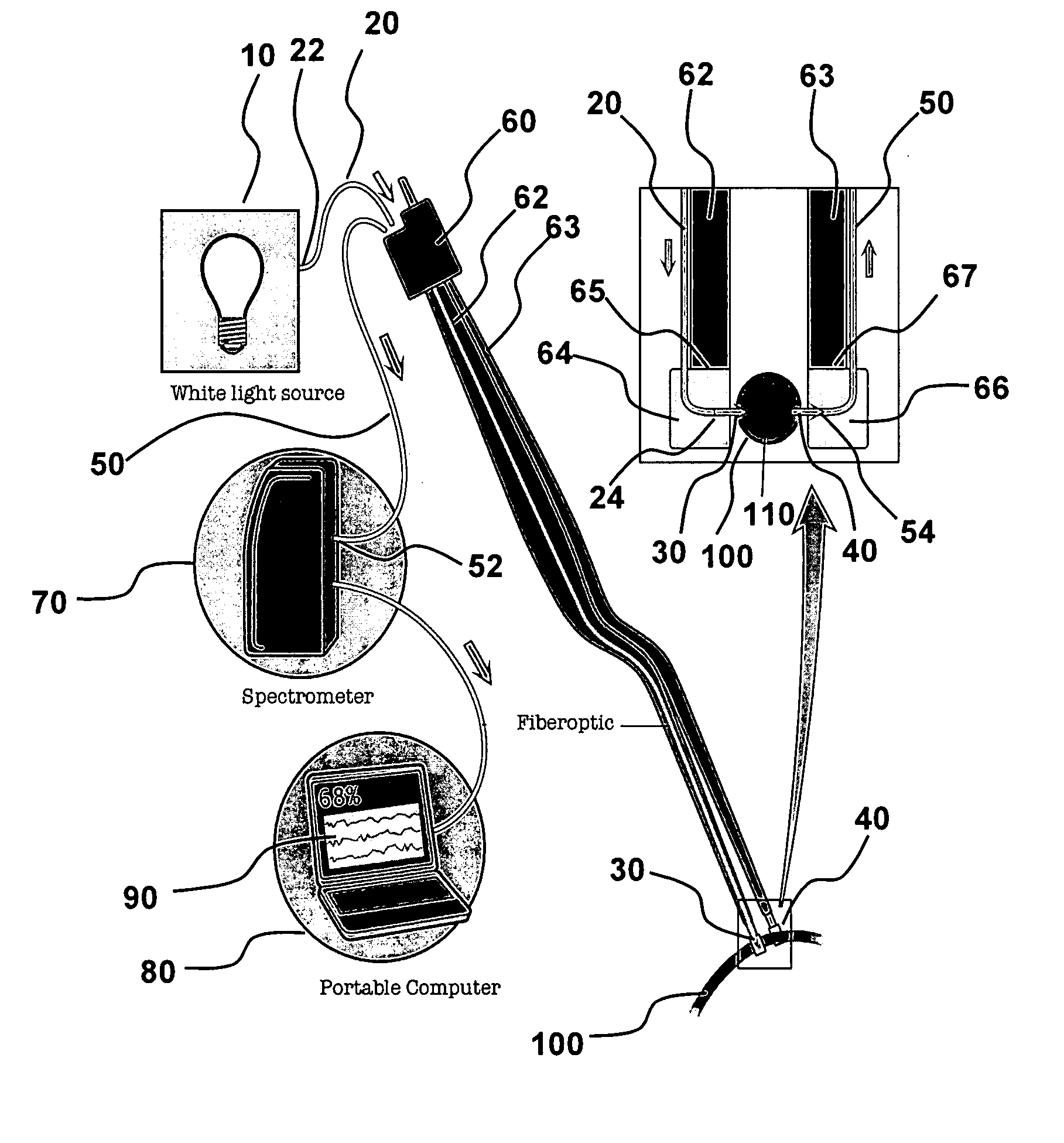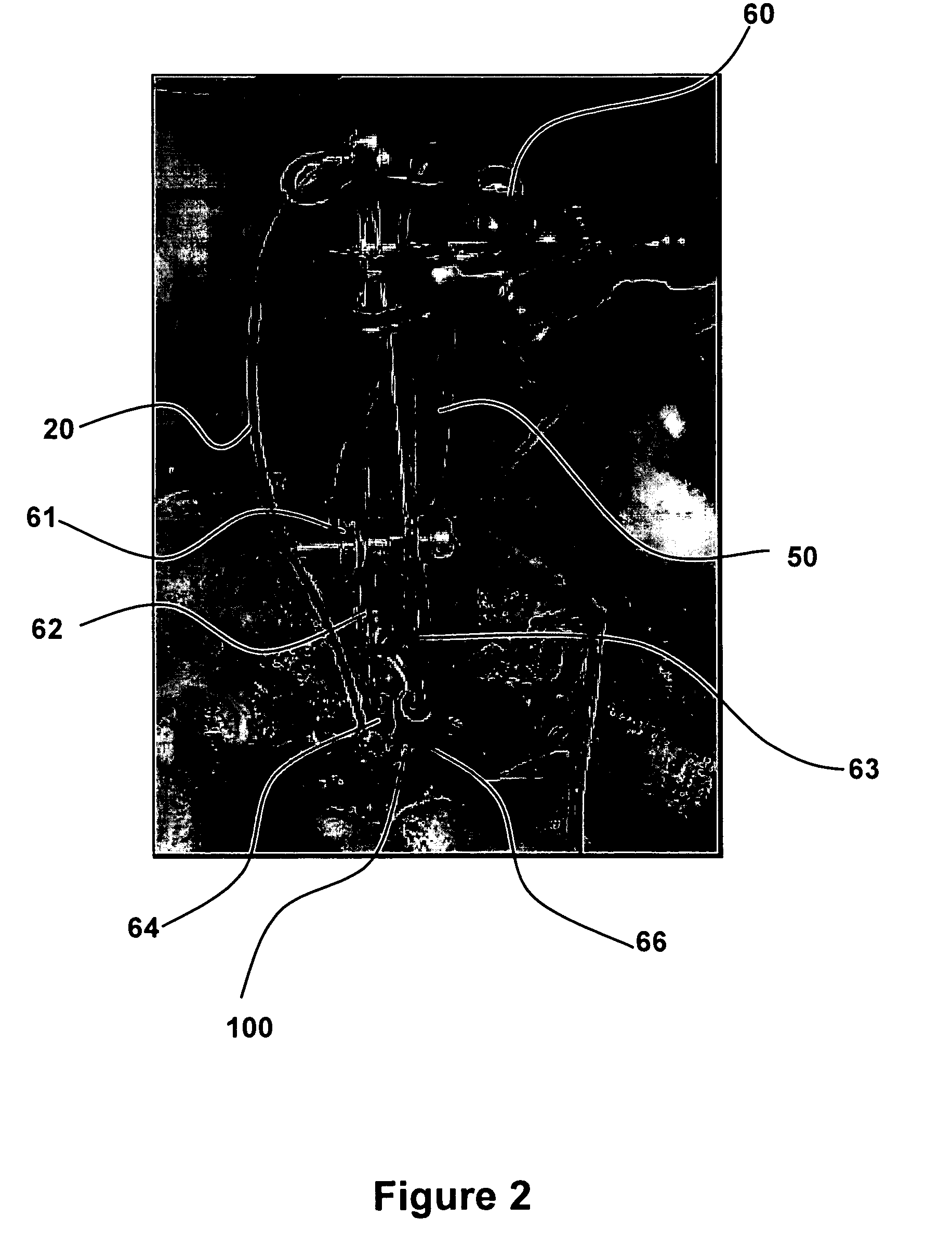Optical microprobe for blood clot detection
- Summary
- Abstract
- Description
- Claims
- Application Information
AI Technical Summary
Benefits of technology
Problems solved by technology
Method used
Image
Examples
example 1
Optical System for Detecting Clots
[0053]Referring to FIG. 1, electromagnetic radiation (“emr”) source 10 is connected to first fiber optic strand 20 at proximal end 22 and positioned to illuminate blood vessel 100 with emr 30 from distal end 24. A second fiber optic strand 50 collects emr 40 at distal end 54 that has traveled through blood vessel 100. The collector fiber optic 50 transmits the collected emr 40 to a detector 70 that is optically connected at second strand proximal end 52. The detector 70 is illustrated as a spectrometer that is able to measure an optical property of the collected emr 40. In an aspect, the optical property is the intensity of emr 40 (or a parameter obtained therefrom, such as absorbance, relative absorbance, or absorption coefficient) at one or more wavelengths. In an aspect, the optical property is assessed over a wavelength range, such as a spectrum of intensity or absorbance, including a wavelength range that spans all, or a portion of the NIR. The...
example 2
In Vitro Clot Detection
[0065]Whole blood from the animal is collected and deposited in a cuvette to generate a blood clot. The device pictured in FIGS. 1 and 2 is used to obtain spectral information during the clotting process. Once the blood is completely clotted inside the cuvette, spectral analysis with a spectrometer characterizes and stores the spectral components. Spectral components, with respect to the spectrum over the NIR, refers to the influence of RBCs, and specifically Hb that is either oxygen bound or oxygen unbound, and clot components. Without wishing to be constrained to any particular theory, because the main component of the blood clot is trapped red blood cells that are unable to re-oxygenate, the blood clot spectrum is believed to be similar to the spectrum of HHb.
[0066]FIG. 4 provides the absorption spectrum of clotted blood in a cuvette. The rapidly fluctuating spectrum is the raw intensity data of the blood. The smooth curve is the relative absorption spectru...
example 3
Clot Detection in Blood Vessels
[0071]The optical microprobe system used for the in vitro experiments is used on ten six-month old male rats (Rattus Norvergicus Wistard) weighing about 500 g. During the procedure the animals are anesthetized with Ketamine (100 mg / kg), Xylazine (5 mg / kg) and Acepromazine (1.0 mg / kg). Depth of anesthesia is tested by foot pinch every 15 minutes. Supplemental doses of Ketamine 30 mg / kg and Xylasaline 1.75 mg / kg are given as necessary. In order to ensure adequate ventilation and oxygenation of the tissues, a traqueostomy is performed that connects the airway to a ventilator. The ventilator is set by visually observing the degree of lung expansion. The average breath per minute is about 85, producing an average tidal volume of 1.5 mL. The minute volume is 100 mL / min (range 75-130 mL / min). Because this technique is highly sensible to changes in hematocrit and the surgery can result in animal bleeding, measurements of capillary hematocrit and hemoglobin con...
PUM
 Login to View More
Login to View More Abstract
Description
Claims
Application Information
 Login to View More
Login to View More - R&D
- Intellectual Property
- Life Sciences
- Materials
- Tech Scout
- Unparalleled Data Quality
- Higher Quality Content
- 60% Fewer Hallucinations
Browse by: Latest US Patents, China's latest patents, Technical Efficacy Thesaurus, Application Domain, Technology Topic, Popular Technical Reports.
© 2025 PatSnap. All rights reserved.Legal|Privacy policy|Modern Slavery Act Transparency Statement|Sitemap|About US| Contact US: help@patsnap.com



